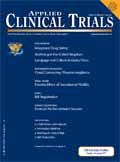Current Challenges of Poor R&D
Applied Clinical Trials
Transfer of material between the supply cahins can be time consuming and complicated
Pharmaceutical R&D productivity is at an all-time low; the quest to discover new medicines has never been more challenging. Data on R&D pipeline attrition indicates that only 8% to 10% of molecules entering into clinical development will survive through to commercial launch.

For every new medicine that makes it to market at least 10 molecules enter into the development process at the point of the first-in-human dose. The majority of molecules will fail at some point along the way; taking the "cost of failure" into account, the average cost of bringing a new medicine to market is now over $1 billion.
The industry has addressed this challenge by implementing a more flexible development paradigm. The numbers of drug candidates being progressed into development have increased. The molecules are targeted against an expanded range of novel molecular mechanisms, striving to streamline and shorten development processes, speeding the time to market.
Early development has become part of the research continuum and, for these new strategies to deliver, it is imperative that the interrogation of each molecule is sufficiently extensive to differentiate the "winners" from the "losers" prior to a commitment to allocate the funds for full development. This presents the early development project team with a paradox. On one hand, they are challenged to accelerate development time lines, while at the same time driven to undertake increasingly complex clinical investigations to identify any risks associated with the drug candidate. Organizational structures and development processes must evolve to enable a more flexible and interrogative approach to early development.
Current structures and processes to support early development have evolved from legacy working practices. The industry has consolidated around two vertically integrated supply chains focused on the "making" of test materials, and the "testing" of those materials. This approach has been replicated in the outsourcing industry with a strong demarcation between contract development and manufacturing organizations and CROs. Transfer of material between the supply chains can be time consuming and complicated. In addition to the obvious management burden that this process invokes, it also carries a significant time penalty due to the extended characterization of the drug product required to support its passage within the supply chains.
A translational pharmaceutics platform in which the processes, teams, and facilities required to support formulation development, GMP drug product manufacturing, and clinical testing are integrated can drive innovation within early development. Such a platform can enable the rapid and seamless manufacturing-to-clinic transfer of drug product, with manufacturing often taking place within the 24-hour period prior to dosing. The time savings that can be delivered by this approach are significant, typically being reduced by a third to half. The ability to undertake on-demand manufacturing of drug product in such close proximity to the clinical dosing period means that the data from one clinical period can inform the drug product to be manufactured and tested in the next clinical period(s).
This provides much greater flexibility in the design of an early development program and, when implemented within a regulatory environment that is permissive for early development, equips the project team with a powerful toolbox to interrogate development molecules and readily separate the winners from the losers. This approach provides a firm foundation to deliver the new R&D paradigm and improve pharma R&D productivity.
Mark Egerton, MD Managing Director Quotient Clinical E-mail: [email protected]

Improving Relationships and Diversifying the Site Selection Process
April 17th 2025In this episode of the Applied Clinical Trials Podcast, Liz Beatty, co-founder and chief strategy officer, Inato, discusses a number of topics around site engagement including community-based sites, the role of technology in improving site/sponsor relationships, how increased operational costs are impacting the industry, and more.